Preservation takes it on the chin (updated)
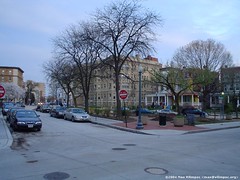 Mt. Pleasant Street, DC, photo by Vilimpoc.
Mt. Pleasant Street, DC, photo by Vilimpoc.A problem with newspapers and newspaper columnists, which started back in the days with the "sob sisters" and Hearsts and Pulitzer with their newspapers in New York City, is the focus on the individual story, the exception to the rule.
The story is that one of these publishers put two stories on the front page. One sought donations for a poor woman and her child. The other donations for a penniless scientist working on a medical breakthrough. Donations for the woman and child far outspanned donations to the scientist. That day the newspaper learned which stories would best appeal to their readers. The "sob sister" columnists back then, and today's columnists given the beat writing human interest stories, often featuring "the little guy vs. the seemingly uncaring bureaucracy" are the result of this important lesson.
So, the article in today's Post by Marc Fisher, "Putting Home's Appearance Ahead of Helping Frail Couple," conveniently focuses on the trials and issues of one particular household, that likely does need some accommodations because of their advancing ages.
I don't know enough about the specifics to be willing to comment about this particular case, possible accommodations or to suggest a second look, or a willingness to approve a "temporary" change that would have to be corrected once the family finally leave "this world."
------------
Update: However, I have been told that the back of the building has an at-grade entrance (as do many Mount Pleasant houses) immediately accessible to their parking. That the ramp proposed by the owners didn't meet ADA standards. And also that the grade of the proposed ramp meant that a wheelchair-bound person could not move up the ramp unassisted. Plus, the property owner intends to rent out the upper floors.
------------------
But I do know that denigrating the neighborhood because it's "only 70+ years old" is an argument that ignores the reality of urban design, historic architecture, history and authenticity--the building blocks of the city's uniqueness and competitive advantage.
Historic preservation is too often made out to be the "bad guy" in terms of putting "restrictions" on people and their ability to do whatever they want to their buildings, without any care or concern with how such individual decisions can negatively impact others, especially property values. In many respects, historic preservation is about protecting the majority from the bad taste of the minority.
(And this is part of what Foglesong, in Planning the Capitalist City, calls the property contradiction of balancing private property interests vis-a-vis social needs and character of the land, and the need for protection against the possible bad decisions of others, which by the way, is the entire legal justification of zoning.)
More importantly with regard to the center cities and revitalization, historic preservation of neighborhoods has been absolutely essential, the foundation of the only sustainable strategies for resident retention and attraction, stabilization and revitalization.
If you don't believe me, look at the results of urban renewal. These days, most every significant urban renewal project of the 1950s-1980s is being reworked, because of a lack of success (a/k/a failure).
DC would not be a great place to live, it would be like Detroit or Newark, if it weren't for the preservation movement.
Preservationists stabilized DC neighborhoods that likely would have been abandoned or remade over by urban renewal, if it weren't for their willingness to buck the trends of outmigration from the center cities. They stayed and "toughed it out" and put in the hard slog to make things better, rather than to just move away to something new, without the problems that could only be rectified by hard work, effort, and community organizing.
I joke that the crotchety preservationists today who are now in their 60s and 70s (in DC, think Dick Wolf, president of the Capitol Hill Restoration Society) were the hip urban pioneers of the 1950s, 1960s and 1970s.
These are the people who saved the city for those of us who willingly enjoy the fruits of their efforts and are moving back to the center city today.
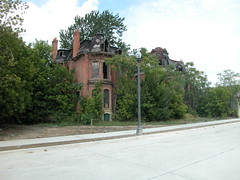 The City of Detroit was once one of the wealthiest and largest cities in the United States. While benefiting from the wealth of the auto industry, at the same time the auto industry fueled suburban outmigration, and the state of Detroit today represents the end game for automobility vs. the center city. Photos from Shrinking Cities.
The City of Detroit was once one of the wealthiest and largest cities in the United States. While benefiting from the wealth of the auto industry, at the same time the auto industry fueled suburban outmigration, and the state of Detroit today represents the end game for automobility vs. the center city. Photos from Shrinking Cities.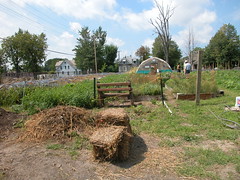 With up to a 1/3 of the city--55+ square miles--now vacant land, urban agriculture is potentially viable within the city of Detroit.
With up to a 1/3 of the city--55+ square miles--now vacant land, urban agriculture is potentially viable within the city of Detroit.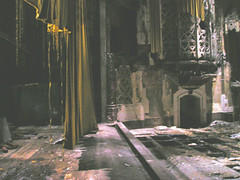 United Artists Building, Detroit. Once thriving, many buildings--skyscrapers, industrial buildings--especially in the Downtown, have been left to rot.
United Artists Building, Detroit. Once thriving, many buildings--skyscrapers, industrial buildings--especially in the Downtown, have been left to rot.And there is no question that Washington can ill afford the constant desire to dumb down the quality of the built environment through little changes that cumulatively have a huge impact. Even the legacy of L'Enfant and the pre-1930 builders and artisans who built residences and commercial buildings of great beauty and distinction cannot withstand death from 1,000 cuts.
No Toll Brothers or K. Hovnanian subdivision, or even a New Urbanism community like Kentlands in Montgomery County, can compare to the vernacular beauty and charm of DC neighborhoods constructed before 1935.
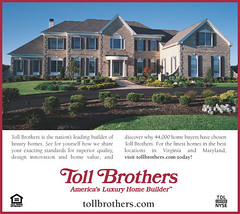
Given the sprawl and mass production of housing that typifies the subdivisions created further and further out from the center city, I wish the Washington Post and its columnists would take the time to do features on the people in this city through their hard, often selfless, and too often ignored and unappreciated efforts over the past 40+ years to keep this city and its neighborhoods viable when all the trends favored the suburbs.
I have been poking through back issues of the Journal of the American Planning Assocation over the past few weeks, and generally issues of the journal from the 1960s through the early 1990s contained articles that for the most part figured that center cities were beyond redemption, that contraction was the only hope, and that somehow ways had to be found to help those lowest income residents who tended to concentrate in center cities to reconnect themselves and their neighborhoods to increasingly disinterested suburbs.
Times have changed--cities like Washington and New York are thriving. Other cities like Philadelphia and Boston are stabilized and improving, despite overall negative trends. Chicago has been stable all along. And Downtowns and neighborhoods in many center cities are managing to recover, stabilize, and attract new residents and businesses.
But it was hardly an overnight process. It has been a long slog of decades, and historic preservation has been the heart and soul of the revitalization.
Forget that at your peril.
And if you don't believe me, read Cities: Back from the Edge, The Living City, and Changing Places to educate yourself.
Then we might be able to have an intelligent conversation.
Until then, we'll be talking past each other, because you'll want to focus on uniqueness, whereas I want to focus on drawing out meta-lessons, what works, why, and replicating success.

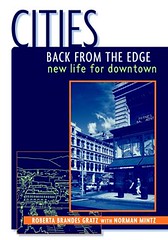
(Note: Mt. Pleasant also reflects another trend that has in large part bypassed DC, but not other center cities. That is in-migration to the center city of foreign immigrants. Mt. Pleasant and Adams-Morgan and Columbia Heights did receive a large influx of Hispanics. But generally, even in bad times, the relatively high cost of property in DC proper meant that immigrants tended to settle in DC's suburbs. This is why Fairfax County is a center for Korean, Vietnamese and other Asian peoples, and why places like Langley Park are heavily Hispanic. There is also an Ethiopian presence in DC, especially pronounced in the small business sector. See "It appears as if I am becoming a sociologist...")
Index Keywords: historic-preservation; urban-revitalization; urban-design-placemaking



0 Comments:
Post a Comment
<< Home